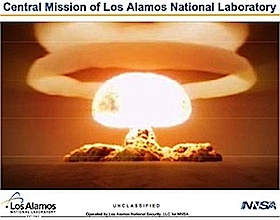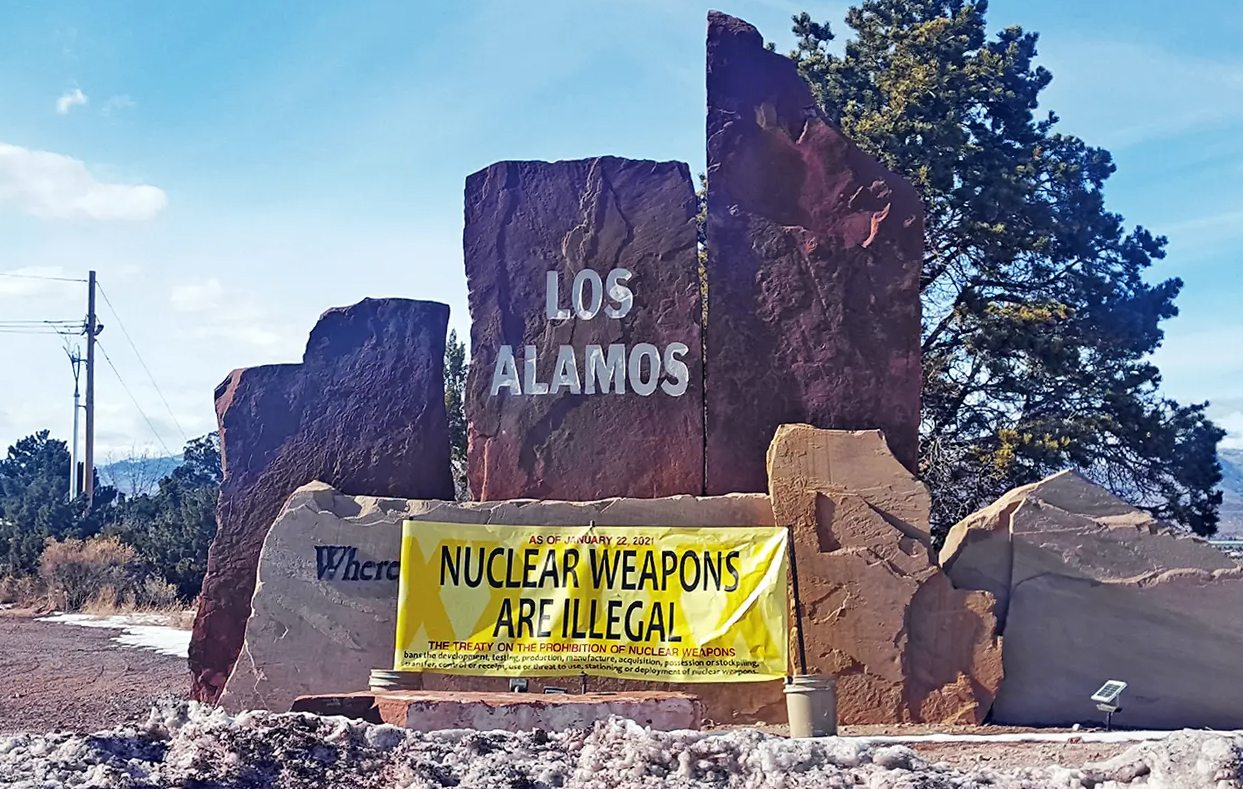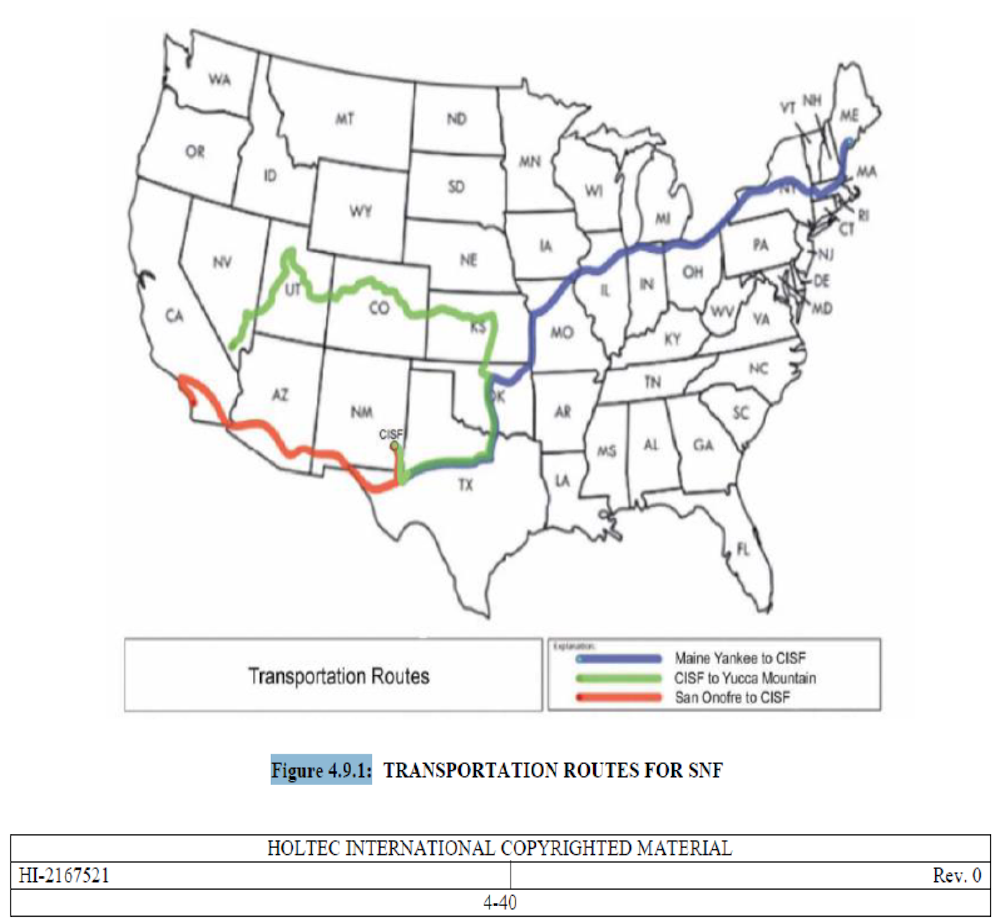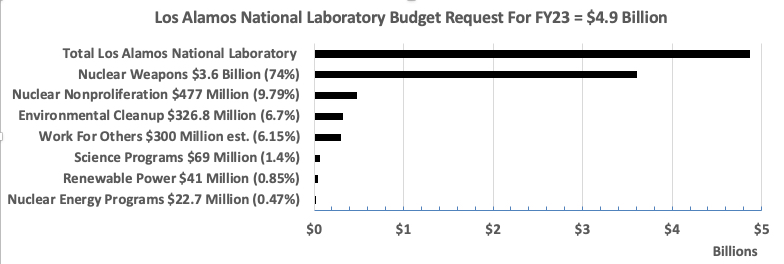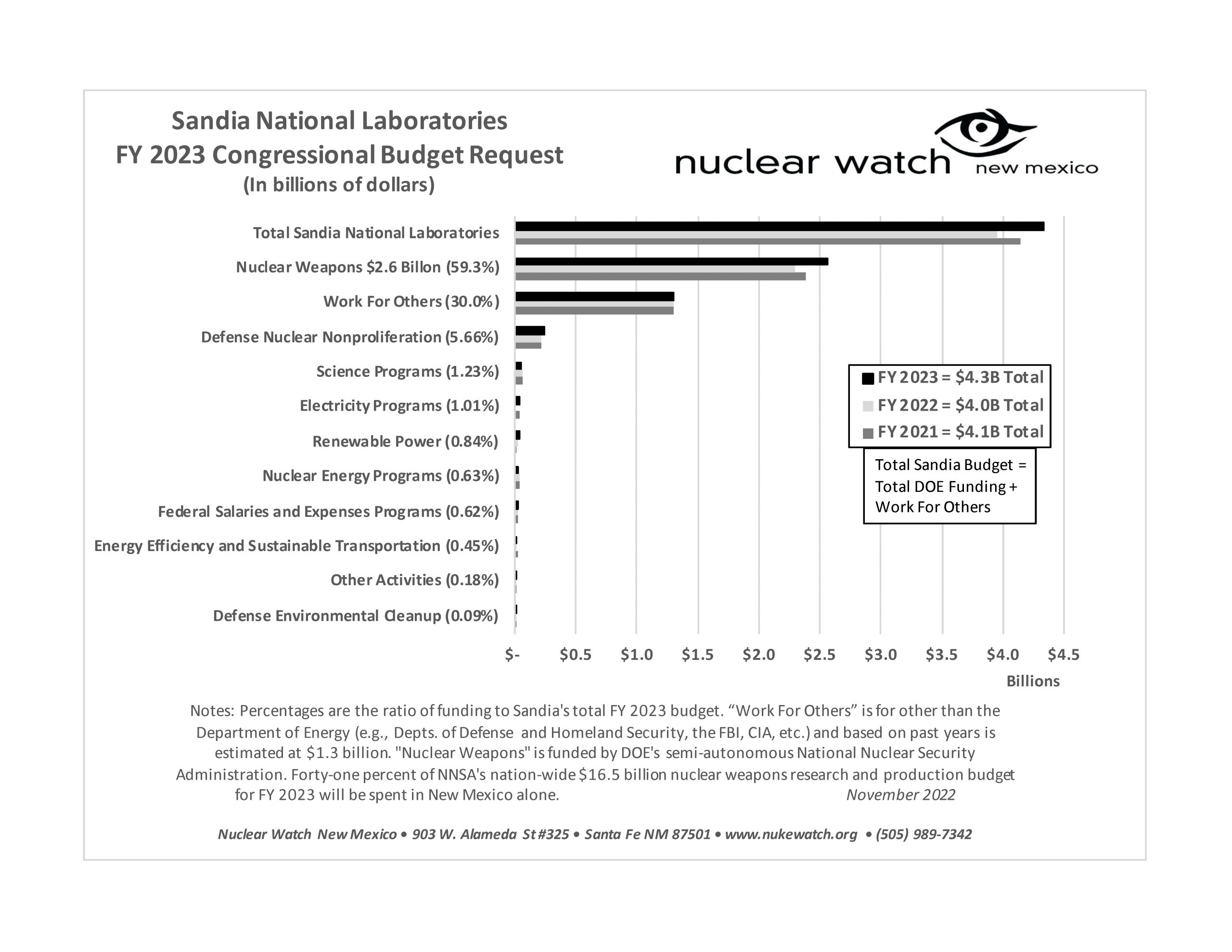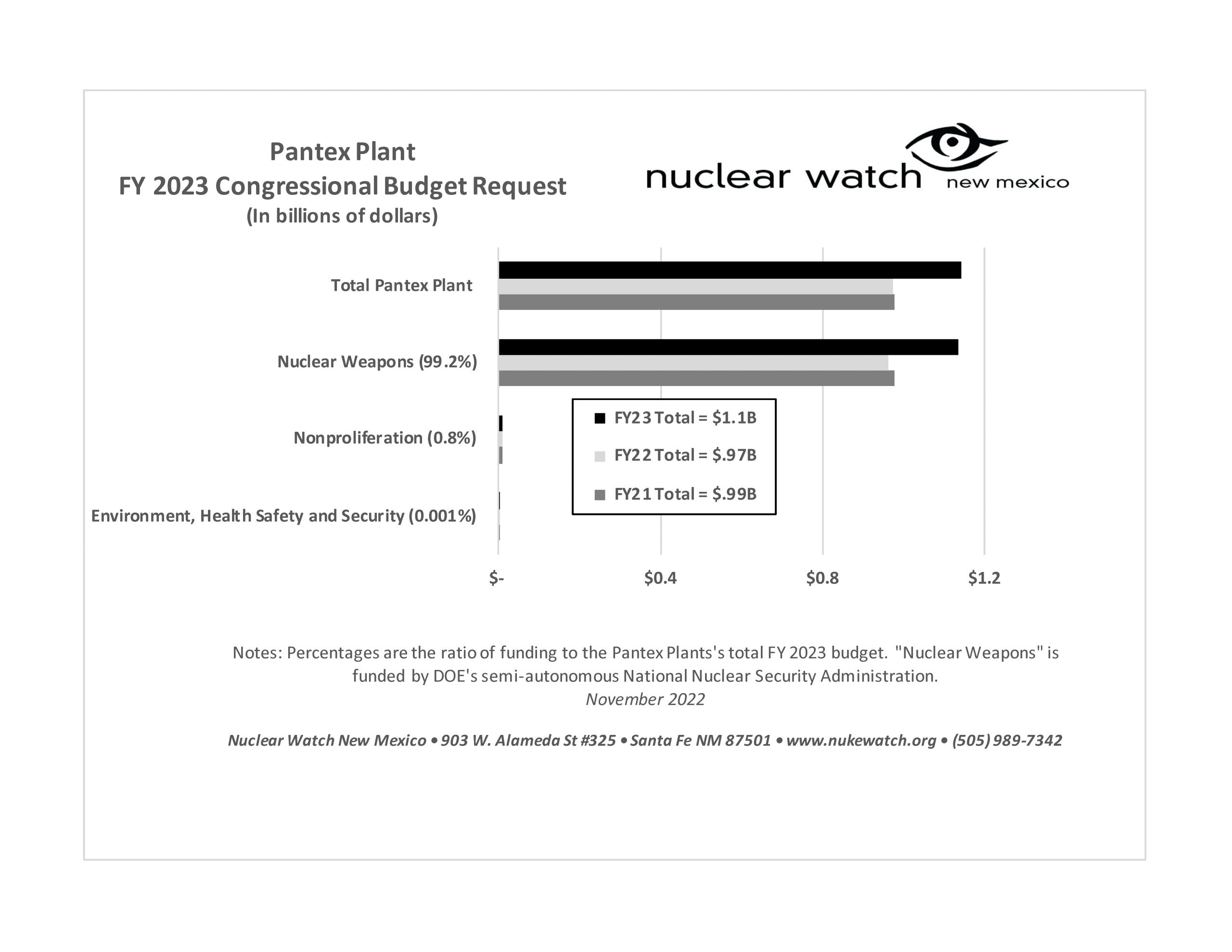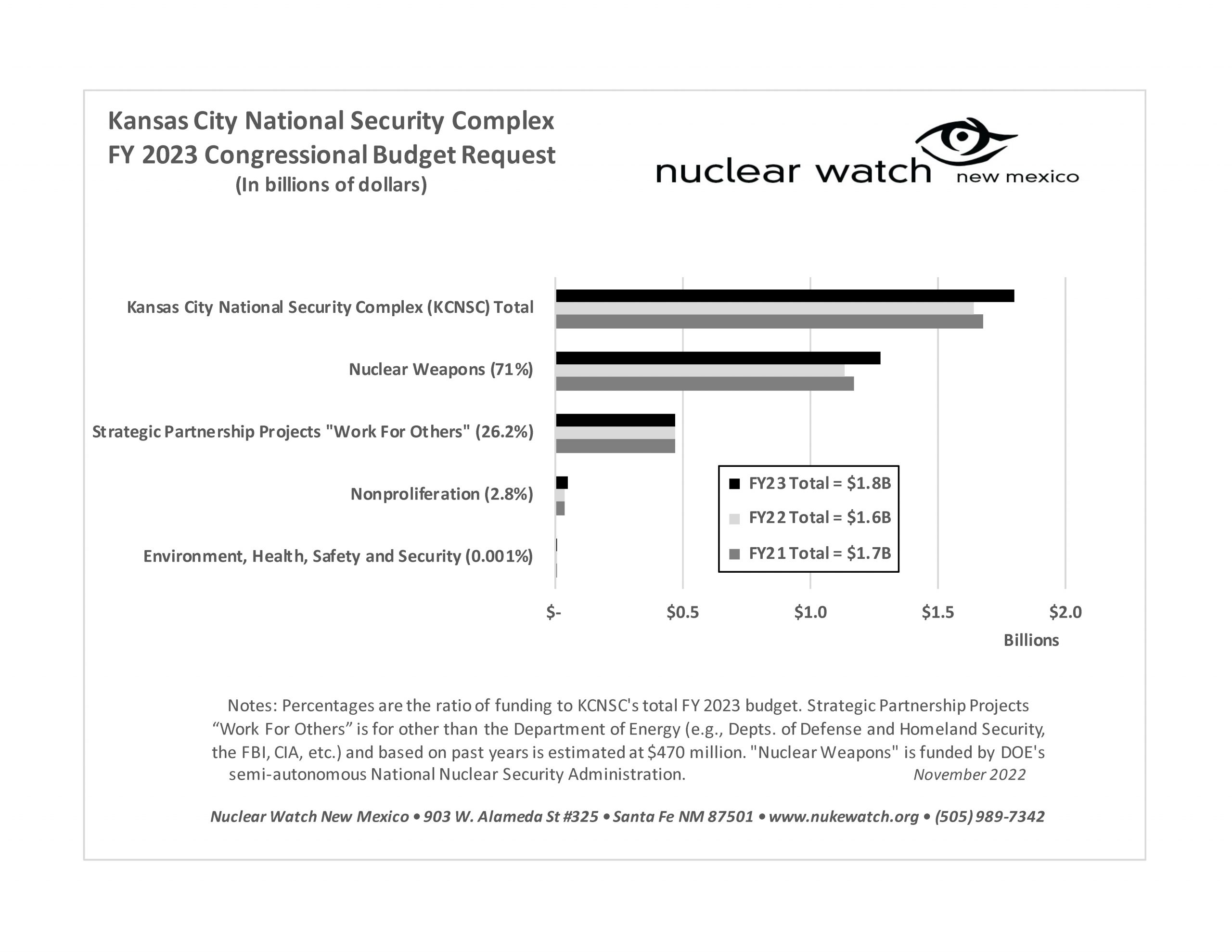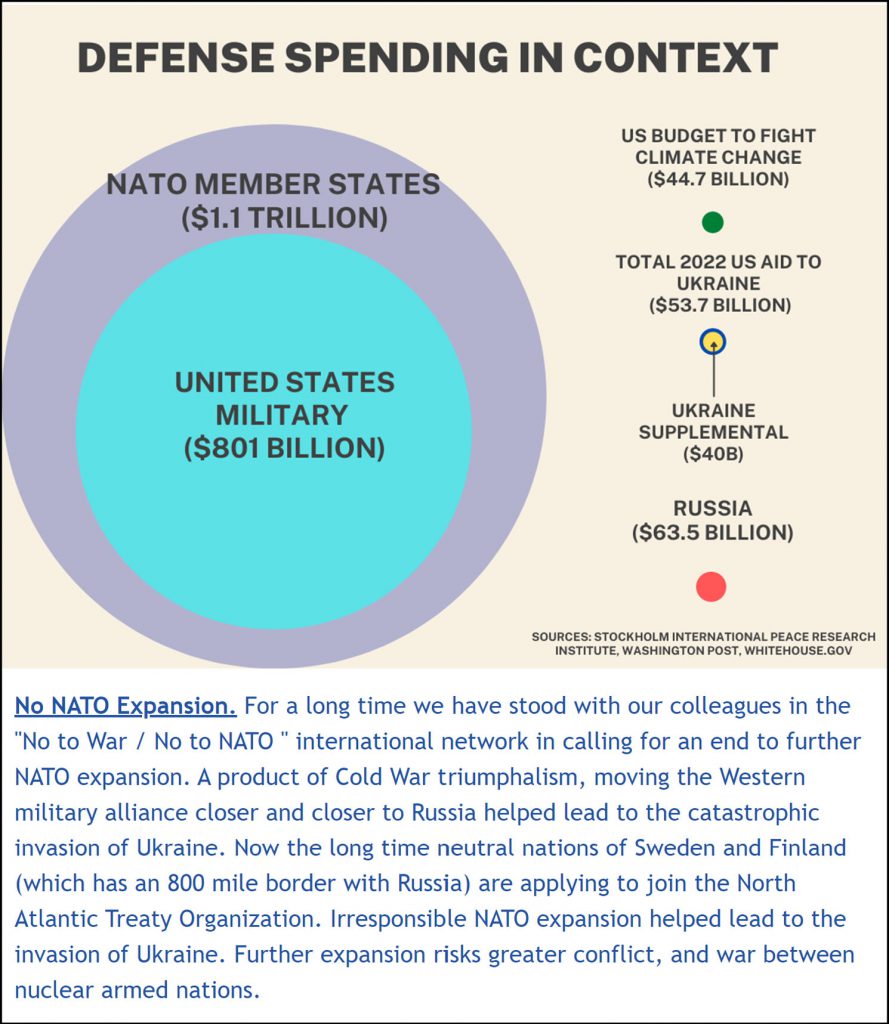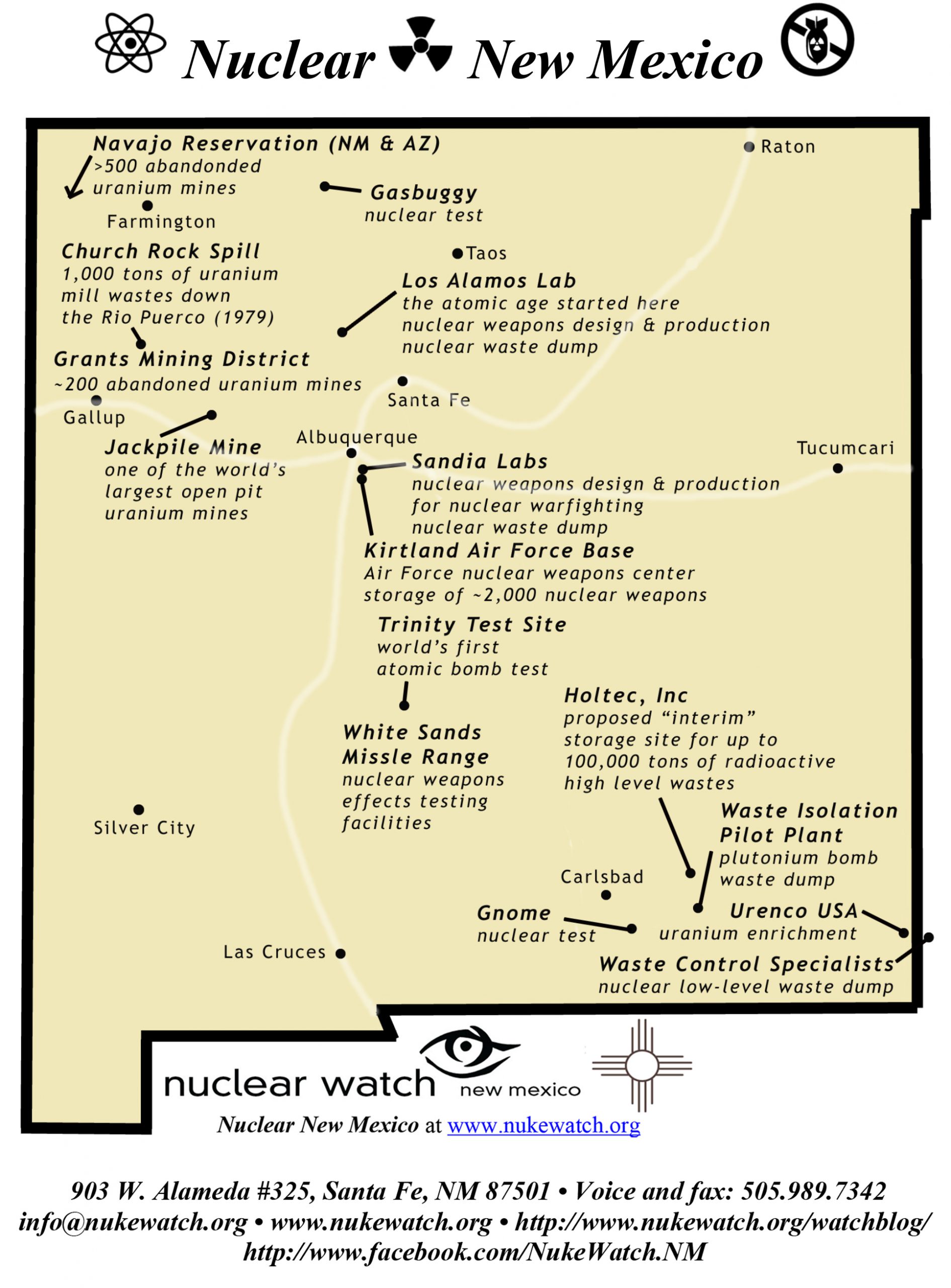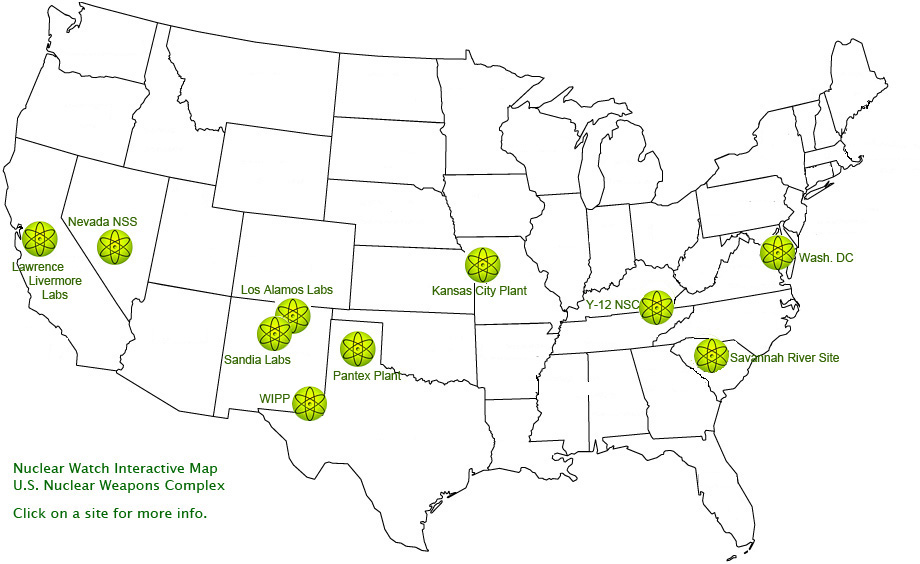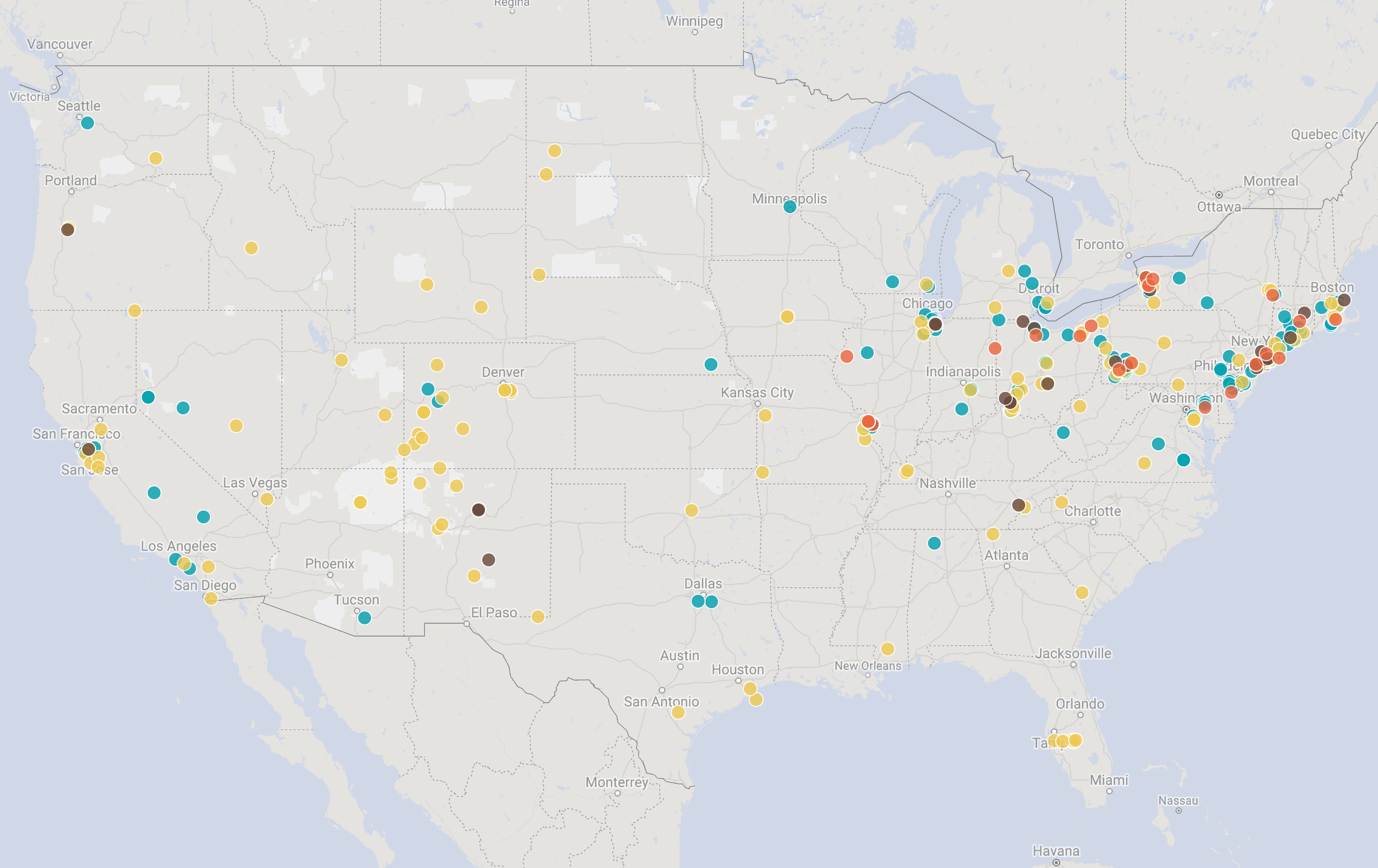QUOTE OF THE WEEK
Nothing Found
It seems we can’t find what you’re looking for. Perhaps searching can help.
LANL’s Central Mission: Los Alamos Lab officials have recently claimed that LANL has moved away from primarily nuclear weapons to “national security”, but what truly remains as the Labs central mission? Here’s the answer from one of its own documents:
LANL’s “Central Mission”- Presented at: RPI Nuclear Data 2011 Symposium for Criticality Safety and Reactor Applications (PDF) 4/27/11
Banner displaying “Nuclear Weapons Are Now Illegal” at the entrance in front of the Los Alamos National Lab to celebrate the Entry Into Force of the Nuclear Weapon Ban Treaty on January 22, 2021
Nothing Found
It seems we can’t find what you’re looking for. Perhaps searching can help.
Follow the Money!
Map of “Nuclear New Mexico”
Nuclear Watch Interactive Map – U.S. Nuclear Weapons Complex
In 1985, US President Ronald Reagan and and Russian President Mikhail Gorbachev declared that “a nuclear war cannot be won and must never be fought.”
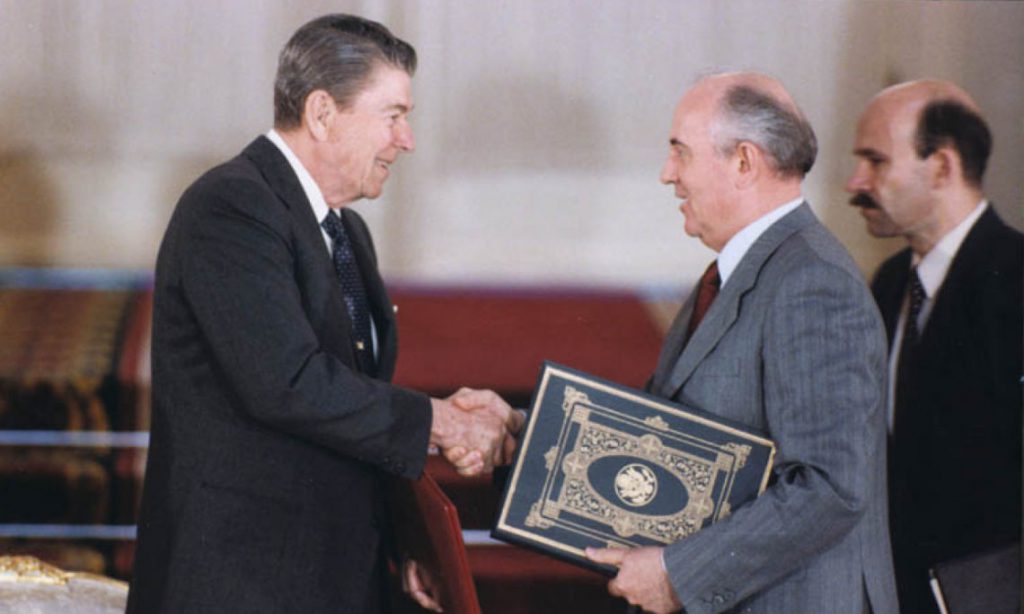
Waste Lands: America’s Forgotten Nuclear Legacy
The Wall St. Journal has compiled a searchable database of contaminated sites across the US. (view)
Related WSJ report: https://www.wsj.com
2022 BLOG POSTS
Nothing Found
It seems we can’t find what you’re looking for. Perhaps searching can help.
New & Updated
Watchdogs Denounce Slap on Wrist for Illegal Lobbying Activities By the World’s Biggest Defense Contractor- and Demand Real Accountability by Barring Lockheed Martin From Future Sandia Labs Contract.
Santa Fe, NM
In a notice given late Friday the Department of Justice announced a settlement with Lockheed Martin over alleged violations of federal anti-lobbying laws to extend its management contract of the Sandia Labs without competition.
Jay Coghlan, Director of Nuclear Watch New Mexico, commented:
4.7 million dollars is a slap on the wrist for the world’s biggest defense contractor to pay. Lockheed Martin clearly broke the law by engaging in illegal lobbying activities to extend its Sandia contract without competition, and earned more than 100 million dollars while doing so. Moreover, it engaged in deep and systemic corruption, including paying Congresswoman Heather Wilson $10,000 a month starting the day after she left office for so-called consulting services that had no written work requirements. There should be criminal prosecutions for clear violations of federal anti-lobbying laws, and Lockheed Marin should be barred from future competition for the Sandia Labs contract, expected next year. Holding the revolving gang of greedy politicians and contractors strictly accountable is essential as they get ready to fleece the taxpayer during the planned one trillion dollar “modernization” for what the nuclear weapons labs are now calling “The Second Nuclear Age.”
Federation of American Scientists
Nuclear Watch New Mexico
For immediate release August 12, 2015
Contacts: Jay Coghlan, NWNM, 505.470.3154, jay[at]nukewatch.org
Hans Kristensen, FAS, 202.454.4695, hkristensen[at]fas.org
Robert Alvarez, IPS, 301.585.7672, kitbob[at]rcn.com
Dr. James Doyle, nonproliferation expert, 505.470.3154, jimdoyle6[at]msn.com
Nuclear Weapons Experts File Amicus Brief
To Support Marshall Islands Lawsuit
To Require Nuclear Disarmament Negotiations
Under U.S. NonProliferation Treaty Commitments
Washington, DC and Santa Fe, NM – Four nuclear weapons experts have filed an amicus (“friend of the court”) brief in support of a lawsuit filed by the Republic of the Marshall Islands to compel the United States to meet its requirements under the Nuclear NonProliferation Treaty (NPT). The basic bargain of the NPT is that non-weapons states agreed to never acquire nuclear weapons, in exchange for which nuclear weapons states promised to enter into good faith disarmament negotiations. Ratification of the treaty by the Senate in 1970 made its provisions the law of the land under the U.S. Constitution.
The experts filing the brief are: Hans Kristensen, Director of the Nuclear Information Project at the Federation of American Scientists; Dr. James Doyle, a nuclear nonproliferation expert fired by the Los Alamos national lab after publishing a study arguing for nuclear weapons abolition; Robert Alvarez, a former Senior Policy Advisor to the Secretary of Energy, now at the Institute for Policy Studies; and Jay Coghlan, director of Nuclear Watch New Mexico.
Hans Kristensen explained, “The United States, as one of the five original nuclear weapons states under the NPT, has a clear legal obligation to pursue negotiations toward nuclear disarmament. Yet despite progress on reducing overall nuclear arsenals, forty-five years later there are and have been no negotiations on their elimination. Instead, all nuclear weapon powers are pursuing broad and expensive modernization programs to retain and improve nuclear weapons indefinitely.”
The Marshall Islands’ lawsuit, which was filed in federal court in San Francisco, asserts that the U.S. has failed to fulfill its treaty duties. The case was initially dismissed in February 2015 by a federal judge after the U.S. government argued in part that enforcement of the NPT’s requirement for nuclear disarmament negotiations was not in the public interest. This is now being appealed. As the Marshall Islands’ original complaint notes, “While cessation of the nuclear arms race and nuclear disarmament are vitally important objectives to the entire international community, the Marshall Islands has a particular awareness of the dire consequences of nuclear weapons.” While still a U.S. protectorate after World War II, the American nuclear weapons complex used the Marshall Islands for more than a hundred atmospheric nuclear weapons tests that included newly developed H-bombs, and the displaced Marshallese have suffered severe health and contamination effects to this day. However, the Marshall Islands’ lawsuit is not asking for compensation, but instead seeks to hold the nuclear weapons powers accountable to the NPT’s requirement for good faith nuclear disarmament negotiations.
Andrea St. Julian, an attorney based in San Diego who specializes in federal appellate proceedings, filed the 94-page amicus brief. She observed, “The level of expertise and understanding the amici bring to this appeal is remarkable. Their arguments show how profoundly mistaken the district court was in its misapplication of the law. If the Court of Appeals takes adequate note of the briefing, it will have no alternative but to reverse the dismissal of the Marshall Islands’ suit. If not, we expect the Marshall Islands to take its case to the U.S. Supreme Court, and we will strongly support it there.”
Dr. James Doyle commented, “It’s not possible to eliminate the knowledge to build nuclear weapons, but it’s possible to make them illegal and remove them from all military arsenals, as existing treaties on chemical and biological weapons have already substantially done. The Marshall Islands’ case is an important step on the path to the elimination of nuclear weapons and deserves a ruling by the U.S. Supreme Court.”
Robert Alvarez added, “The Republic of the Marshall Islands has exposed the abuse of the good faith and trust of the non-weapons states that signed the NonProliferation Treaty on the understanding that the nuclear weapons states would begin disarmament negotiations. By seeking a binding legal requirement to actually begin negotiations, the Marshall Islands is simply trying to get the United States to honor the promises and commitments it made to the world 45 years ago.”
Jay Coghlan noted that the recently concluded 2015 NPT Review Conference ended in failure, in large part because nuclear weapons nations are modernizing their arsenals. He observed, “The U.S. government is getting ready to spend a trillion dollars on new production facilities for nuclear weapons and new bombers, missiles and submarines to deliver them. Because of that, we are keen to help the Marshall Islands hold the U.S. and other nuclear weapons powers accountable to their end of the NPT bargain, which is to enter into disarmament negotiations.”
# # #
The amicus brief is available at https://nukewatch.org/importantdocs/resources/Dkt-38-Amicus-Brief.pdf
Bios of the four amici are available in the amicus brief, beginning page 1.
Complete 9th circuit court proceedings in the Republic of Marshall Islands’ lawsuit are available at https://www.wagingpeace.org/nuclearzero/
Amicus Brief in Support of Marshall Islands Lawsuit
In April 2015 the U.S. State Department issued a so-called Fact Sheet entitled Myths and Facts Regarding the Nuclear Non-Proliferation Treaty and Regime. Its targeted audience was international delegations attending the 2015 NonProliferation Treaty (NPT) Review Conference. Given the increasing dissatisfaction of non-nuclear weapons states, the State Department argued that numerical stockpile reductions since the end of the Cold War is ample evidence that the U.S. is complying with the NPT’s Article VI obligation for nuclear disarmament.Continue reading
Nuclear Weapons Experts File Amicus Brief to Support Marshall Islands Lawsuit to Require Nuclear Disarmament Negotiations Under U.S. NonProliferation Treaty Commitments
Hans Kristensen, Director of the Nuclear Information Project at the Federation of American Scientists; Dr. James Doyle, a nuclear nonproliferation expert fired by Los Alamos National Lab after publishing a study arguing for nuclear weapons abolition; Robert Alvarez, a former Senior Policy Advisor to the Secretary of Energy, now at the Institute for Policy Studies; and Jay Coghlan, director of Nuclear Watch New Mexico, have filed an amicus (“friend of the court”) brief in support of a lawsuit filed by the Republic of the Marshall Islands to compel the United States to meet its requirements under the Nuclear NonProliferation Treaty (NPT).
Major Protests at U.S. Warhead Facilities Across the Nation Unite to Decry Trillion Dollar Plan for New U.S. Nuclear Weapons
For more information:
Ralph Hutchison, Oak Ridge Environmental Peace Alliance, orep@earthlink.net <mailto:orep@earthlink.net> , 865-776-5050
Marylia Kelley, Tri-Valley CAREs, Livermore, mailto:marylia@trivalleycares.org <mailto:marylia@trivalleycares.org> , 925-443-7148
Other key national and regional contacts are listed at the end of this release
For immediate release, August 4, 2015
HISTORIC 70TH ANNIVERSARY OF ATOMIC BOMBING OF HIROSHIMA, NAGASAKI:
Major Protests at U.S. Warhead Facilities Across the Nation Unite to Decry Trillion Dollar Plan for New U.S. Nuclear Weapons; Advocate Disarmament
A thousand or more peace advocates, Hibakusha (A-bomb survivors), religious leaders, scientists, economists, attorneys, doctors and nurses, nuclear analysts, former war planners and others across the country are coming together to commemorate the 70th Anniversary of the U.S. atomic bombings of Hiroshima and Nagasaki this August 6 through 9 at key sites in the U.S. nuclear weapons complex.
Major commemorations, rallies, protests and/or nonviolent direct actions will place at the Lawrence Livermore National Laboratory in CA, the Los Alamos National Laboratory in NM, the Kansas City Plant in MO, the Y-12 Plant in TN, the Rocky Flats Plant in CO, the Pantex Plant in TX, and in GA near the Savannah River Site. These events are united by their reflection on the past, and, uniquely, their focus on the present and future with a resolute determination to change U.S. nuclear weapons policy at the very locations that are linchpins in producing the new trillion dollar stockpile of nuclear weapons and their delivery vehicles.
“We stand on the brink of a new, global nuclear arms race,” noted Ralph Hutchison, the longstanding coordinator for the Oak Ridge Environmental Peace Alliance. “This is epitomized by government plans for a new Uranium Processing Facility to produce H-bomb components at Y-12, including for new-design weapons.”
“U.S. plans to ‘modernize’ the arsenal are also underway at Livermore Lab,” stated Marylia Kelley, Tri-Valley CAREs’ executive director. “A new Long-Range Stand Off warhead design and the start of plutonium shots in the Lab’s National Ignition Facility reveal two facets of this new arms race,” Kelley continued. “In contrast to the cold war, which was largely about sheer numbers, the new arms race and its dangers stem from novel military capabilities now being placed into nuclear weapons.”
Around the world, pressure for the U.S. to show leadership toward the abolition of nuclear weapons is growing. Pope Francis has repeatedly pressed the moral argument against nuclear weapons, inveighing not only against their use but also against their possession. In the wake of the successful Iran agreement, many are suggesting that since it has been settled that it would never be legitimate for Iran to obtain a nuclear weapon, shouldn’t we also agree that the 16,000 nuclear weapons in existence have no legitimacy either. Moreover, 113 governments recently signed the “Humanitarian Pledge,” circulated by Austria, to press the U.S. and other nuclear weapons states to fulfill their disarmament obligations.
Actions this week at U.S. nuclear weapons facilities will highlight the mounting international calls for nuclear abolition, with U.S. organizers lending their deep and often unique “on the ground” knowledge from the gates and fence lines of the facilities involved in creating new and modified U.S. nuclear weapons. “This 70th anniversary should be a time to reflect on the absolute horror of a nuclear detonation,” mused Ann Suellentrop of Physicians for Social Responsibility-Kansas City, “yet the new Kansas City Plant is churning out components to extend U.S. nuclear weapons 70 years into the future. The imperative to change that future is what motivates me to organize a peace fast at the gates of the Plant.”
Key events at U.S. nuclear weapons complex sites include:
• Y-12 – pastoral letter, remembrance, rally and nonviolent direct action, peace fast and lanterns. (More at <> )
• Livermore Lab – peace camp, August 6 rally and nonviolent direct action, peace fast at the gates. (More info at www.trivalleycares.org <http://www.trivalleycares.org> )
• Los Alamos Lab – film screening, panels, rally and conference (More at www.nuclearwatch.org <http://www.nuclearwatch.org> )
• Kansas City Plant – atomic photographers exhibit, speakers, film screening, and peace fast at the gates. (More info at www.psr.org/chapters/kansas/ <http://www.psr.org/chapters/kansas/> )
• Savannah River Site – film screening, vigil, and circle of hope. (More: www.nonukesyall.org <http://www.nonukesyall.org> )
• Rocky Flats Plant – peace quilt, concert, film screening, labyrinth mourning walk. (More from judithmohling76@gmail.com <mailto:judithmohling76@gmail.com> )
• Pantex Plant – Hiroshima exhibit, panel discussion. (More at: www.peacefarm.us <http://www.peacefarm.us> )
These and other Hiroshima events and actions at sites in the U.S. nuclear weapons complex are being led by organizations that are members of the Alliance for Nuclear Accountability, which represents about three dozen groups. More about ANA can be found at www.ananuclear.org <http://www.ananuclear.org> .
ANA contacts available for interviews include:
Joni Arends, Concerned Citizens for Nuclear Safety, jarends@nuclearactive.org <mailto:jarends@nuclearactive.org> , 505 986-1973 (NM sites)
Jay Coghlan, Nuclear Watch New Mexico, jay@nukewatch.org <mailto:jay@nukewatch.org> , 505-989-7342 (NM sites)
Ann Suellentrop, Physicians for Social Responsibility-KC, annsuellen@gmail.com <mailto:annsuellen@gmail.com> , 913-271-7925 (MO site)
Kevin Kamps, Beyond Nuclear, kevin@beyondnuclear.org <mailto:kevin@beyondnuclear.org> , 240-462-3216 (Ohio sites)
Jerry Stein, Peace Farm, Cletus@am.net <mailto:Cletus@am.net> , 806-351-2744 (TX site)
Judith Mohling, Rocky Mountain Peace & Justice Center, judithmohling76@gmail.com <mailto:judithmohling76@gmail.com> , 303-447-9635 (CO sites)
Glenn Carroll, Nuclear Watch South, atom.girl@nonukesyall.org <mailto:atom.girl@nonukesyall.org> , 404-378-4263 (SC, GA sites)
Paul Kawika Martin, Peace Action, pmartin@peace-action.org <mailto:pmartin@peace-action.org> , 951-217-7285 (in Hiroshima)
Ralph Hutchison, Oak Ridge Environmental Peace Alliance, orep@earthlink.net <mailto:orep@earthlink.net> , 865-776-5050 (TN sites)
Marylia Kelley, Tri-Valley CAREs. marylia@trivalleycares.org <mailto:marylia@trivalleycares.org> , 925-443-7148 (CA sites)
Jackie Cabasso, Western States Legal Foundation, United for Peace & Justice, wslf@earthlink.net <mailto:wslf@earthlink.net> , 510-839-5877 (CA sites, calendar of national events)
Additional resources for media:
Physicians for Social Responsibility calendar and map of Hiroshima and Nagasaki actions at: www.psr.org/news-events/events/hiroshimadayevents-2015.html <>
United for Peace and Justice, Nuclear Free Future Month calendar of events at: www.nuclearfreefuture.org <http://www.nuclearfreefuture.org>
###
Please join Nuclear Watch New Mexico and Global Zero at CCA for the premier of “Message from Hiroshima.”
Please help us prepare for Thursday evening by registering today. Speaking of silent auctions, we have a great list of items that can be yours.
For instance, one of the pieces is “Daybreak” by Santa Fe artist Jamie Chase (18” x 24”, 2015)
Other items include this beautiful canvas printed photograph from “Ireland, One Island, No Borders” by Elizabeth Billups and Gerry Adams (16” X 24” 2005)
Chuck Montano will be joining us for a benefit sale of autographed copies of his recently published, “Los Alamos: A Whistleblower’s Diary,” documenting fraud and abuse at the Los Alamos National Laboratory. All sales will benefit us
This Thursday evening, August 6, is the 70th anniversary of the Hiroshima atomic bombing.
Please join Nuclear Watch New Mexico and Global Zero at the Center for Contemporary Arts for the premier of “Message from Hiroshima.” This will followed by a panel discussion of nuclear weapons issues by Valerie Plame of Global Zero, Rev. John Dear of Campaign Nonviolence, and Jay Coghlan of NukeWatch.
Tickets for the event are:
$25 for a 6:30 pm reception with the panel members, the film and panel discussion.
$15 for the film at 7:30 and panel discussion afterward.
Reservations are recommended – call CCA at (505) 982-1338.
https://web.archive.org/web/20181029175616/https://www.ccasantafe.org/cinematheque/upcoming-films
Center for Contemporary Arts, 1050 Old Pecos Trail, Santa Fe, NM
As we work toward a future world free of nuclear weapons, we hope you will join us to commemorate the day that changed history 70 years ago. We look forward to seeing you. If you have any questions, please contact us at 505-989-7342. Tax-deductible financial contributions to the two organizations are encouraged!
Event Sponsored by VES & HET Fund For Change
Special thanks to Santa Fe Brewery Co, Kelly’s Liquor Barn, and CCA.
Response to the Inaccurate Wall St. Journal Op-Ed “The Faded U.S. Nuclear Deterrent”
On July 13, 2015 the Wall Street Journal published an op-ed entitled The Fading U.S. Nuclear Deterrent by Robert Monroe, a retired Navy vice admiral and former director of the Defense Nuclear Agency. The op-ed’s byline is “The next president must restore America’s aging arsenal to face a world of new atomic threats.” Among other things Monroe argues for “an entirely new nuclear-weapons stockpile, including specialized low-yield advanced weapons” and that “military force must be used if necessary” to prevent others from acquiring nuclear weapons.
Jim Doyle submitted the following to The Wall Street Journal seeking to challenge the op-ed’s inaccuracies, which the Journal rejected. Jim is the nonproliferation expert fired by the Los Alamos Lab after writing a study arguing for nuclear weapons abolition. He is also a crucial member of Nuclear Watch New Mexico’s Steering Committee.
Response to the Inaccurate Wall St. Journal Op-Ed “The Faded U.S. Nuclear Deterrent”
“The Fading U.S. Nuclear Deterrent,” By Robert R. Monroe is loaded with factual inaccuracies and bad advice for America’s national security policymakers. As a consequence, Mr. Monroe’s essay is political theater, void of any logical strategic thinking. Unfortunately, Mr. Monroe targets a vulnerability we all share – fear. But America should not scare itself into making bad decisions with our finite national defense resources.
Now and for the foreseeable future our nuclear forces are in no danger of failing to provide deterrence against nuclear attack. Increasingly however, the United States and its allies face a growing panoply of threats including radical Islam, cyber attacks and the consequences of environmental degradation that are immune to nuclear firepower. US national security strategy must make balanced investments in defensive capabilities that can address the full spectrum of threats. Contrary to what Mr. Monroe advocates, defense investments based on a nostalgic preoccupation with the meaningless concept of “nuclear superiority” will weaken America over time and increase our vulnerability to the most likely threats.
Mr. Monroe claims that the “U.S. began a debilitating nuclear freeze” at the end of the Cold War. This is pure disinformation. During the 20 years from 1990-2010 the US completed deployment of the Trident II submarine-launched ballistic missile and the B-2 stealth strategic nuclear bomber and rebuilt the entire Minuteman III land-based nuclear missile force. Additional upgrades to nuclear command and control and warhead accuracy provided the US with the world’s most capable nuclear force. It remains that way today.
During this same timeframe Russia’s nuclear capabilities declined precipitously. By 2006, it had 55 percent fewer intercontinental ballistic missiles, 39 percent fewer strategic bombers, and 80 percent fewer ballistic-missile submarines compared to 1990. The Russian nuclear arsenal continued its decline until approximately 2010 when its nuclear modernization programs began to come on line and initiate restoration of nuclear capabilities that had been maintained by the Soviet Union. China’s nuclear forces with fewer than 250 deployed nuclear warheads remain small compared to the US and Russia which each possess more than 1,500 deployed warheads.
Ironically, nuclear superiority over the last 25 years has not provided America with the strategic advantages implied by Mr. Monroe. Nuclear weapons did not help secure any meaningful victory in Iraq, Afghanistan, Libya, or Syria, did not prevent the rise of Al Qaida, ISIS and Boko Harem or deter Russia’s actions in Georgia and Ukraine. Nuclear weapons did not check China’s assertiveness in the South China Sea, or thwart the DPRK’s acquisition and testing of nuclear weapons. Nuclear weapons cannot give their possessors the ability to prevent or defeat these threats. Other non-nuclear military, diplomatic and strategic capabilities are required.
Mr. Monroe urges us to dismiss President Obama’s goal of a world without nuclear weapons as an “impossible vision” that is “terribly damaging” to America. Perhaps he is comfortable with successive generations of Americans living with the threat of nuclear holocaust for time immemorial. Fortunately, he is in a minority that believes nuclear deterrence can work forever without fail. Science and rationality tell us it cannot.
The most alarming of Mr. Monroe’s fantasies is his description of nuclear deterrence: “You threaten your adversary with intolerable consequences if he does not comply with your demands. Then, through reinforcing actions, you convince him that you have the will and capability to carry out your threat.” Your threat, of course is mutual nuclear suicide. These sound like the delusions of General Jack Ripper from the film Dr. Strangelove, or the motto of so many failed empires that have tried to rule the world.
Mr. Monroe also claims “for the past two decades nuclear deterrence has been missing from the U.S. toolbox.” Bullocks. Nuclear deterrence is a condition that obtains when any nation has the ability to threaten nuclear attack or devastating nuclear retaliation. It has never been absent from US strategy since the deployment of nuclear weapons in 1945. The delusion to which Mr. Monroe ascribes is that nuclear weapons somehow allow us to reliably influence the decisions of our adversaries. They can never provide this capability.
Mr. Monroe advocates the production and testing of “an entirely new nuclear-weapons stockpile, including specialized low-yield advanced weapons.” Such a course of action will not give America the ability to achieve the outcomes it desires in the world. It will most likely encourage other nations to accelerate plans to increase their nuclear arsenals and acquire similar capabilities as some are now doing.
America’s nuclear deterrent is not rusting away but as former US statesmen Schultz, Kissinger, Perry and Nunn have repeatedly warned in these pages “nuclear deterrence is becoming decreasingly effective and increasingly hazardous.” For now American must and is maintaining a more-than-sufficient nuclear deterrent. But developing and testing new types of nuclear bombs and engaging in a new nuclear arms race will not make that deterrent more effective against the full range of threats nor less hazardous. The world’s nuclear weapons addiction leads only to disaster. America, with it partners and allies, needs to lead the way to a better system for international stability and development.
James E. Doyle
Lockheed Martin’s illegal lobbying to extend Sandia contract
The Center for Public Integrity has come out with a hard-hitting article about illegal lobbying by the world’s biggest defense contractor Lockheed Martin to extend its management contract of the Sandia Labs. Sandia contracted former congresswoman Heather Wilson for consulting services that had no written work requirements, although she denies engaging in illegal lobbying activity. Notably, Wilson was the groomed successor to the powerful Republican senator Pete Domenici (“St. Pete” to the labs for the money be brought them), but was defeated by Tom Udall in the 2007 race for the Senate after Domenici retired. Ironically, the “liberal” Udall now functions as the new Pete Domenici from the same budget seat in the Senate Energy and Water Development Appropriations Subcommittee. My point is how deeply in bed the New Mexican congressional delegation is with the nuclear weapons industry in this state, no matter which political party they come from.
But this business about Lockheed Martin engaging in illegal lobbying to extend its Sandia contract takes it to a whole new level. We believe this is a story that won’t go away – – more developments are bound to come. Looking ahead, because of its illegal activities Nuclear Watch New Mexico’s position is that Lockheed Martin should be barred from competing for the Sandia Labs contract when the National Nuclear Security Administration next puts it out for bid, currently scheduled for next year.
The Center for Public Integrity’s must-read article is at
excerpts:
““Given the specific prohibitions against such activity, we could not comprehend the logic of using Federal funds for the development of a plan to influence members of Congress and federal officials to, in essence, prevent competition,” [DOE Inspector General] Friedman said in the report….
In 2009, the report explains, Sandia Corp. hired a consulting firm headed by former U.S. Rep. Heather Wilson, R-New Mexico, and two unnamed former employees of the Energy Department’s National Nuclear Security Administration, at least one of whom previously had oversight authority at the lab. Wilson’s company, Heather Wilson, LLC, provided explicit directions about how to influence the most crucial decision-makers in the contract-award process, according to the IG report.” – End –
A few comments on the article follow, notably begun by Heather Wilson herself, followed by yours truly and Jim Doyle.
For your readers, this is what I said to the reporter of this story: “The full report confirms what I have said all along. I was not a lobbyist for Sandia and I did not contact any federal official — Congressional or Executive — to try to extend the Sandia contract. I was not a member of the “Sandia Contract Strategy Team” that is criticized in the report. Interestingly, someone’s notes from a conversation with me contained in this full report confirm that I advised that contract extension activities should be done by Lockheed Martin, not Sandia. That is the same position taken by the Department of Energy Inspector General.
Jay Coghlan ·
Executive Director at Nuclear Watch New Mexico
I am not contesting what former Congresswoman Wilson says below. But it should be noted that Nuclear Watch New Mexico filed a FOIA request and got her contract with the Sandia Labs. It makes clear that she entered into that contract with Sandia Labs while still serving in congressional office, and started getting paid $10,000 a month the day after she left office. See https://nukewatch.org/facts/nwd/HeatherWilson-Sandia-contract-invoices.pdf
Ms. Wilson then went on to get a similar contract with the Los Alamos Lab. The DOE IG reported that both contracts had no written work requirements. Pretty sweet work if you can get it, $20K a month, and for what?
The Los Alamos and Sandia Labs had to pay back the government the ~$425,000 they paid Wilson, but as far we know she kept the money. Perhaps she didn’t do anything technically illegal, but it sure doesn’t pass the smell test. Especially when she ran for the U.S. Senate as a strong supporter of the nuclear weapons labs that had paid her. She has also served on the Congressional Advisory Panel on the Governance Structure of the National Nuclear Security Administration that made recommendations favorable to the labs. We think she should have resigned from that panel when her conflicts-of-interest were revealed.
That is history. The more profound question now is should Lockheed Martin be allowed to bid for the Sandia contract next year when it has clearly engaged in illegal lobbying activity? Nuclear Watch New Mexico thinks not.
Jay Coghlan
Nuclear Watch New Mexico
www.nukewatch.org
Works at Self-Employed
I certainly have to object to the reported view of Sandia’s Lockheed-Martin management that it is “not merely in the corporation’s best interest, but in the country’s for Lockheed-Martin, Sandia, and the nation to work together towards influencing DOE to retain the Lockheed-Martin team.” Why would it be to the nation’s best interest to retain a contractor that allowed costs for it largest project, the B-61 nuclear bomb refurbishment, to skyrocket from an estimated $4 billion in 2010 to more than $8 billion today? I do not call this good management. The nation deserves better.
[Jim’s self-description as self-employed is an understatement. He is a former Los Alamos Lab nonproliferation expert who authored a study arguing for nuclear weapons abolition, which ultimately led to his firing. He is now self-employed as an independent nuclear weapons nonproliferation expert, and among many other things serves on Nuclear Watch New Mexico’s Steering Committee.]
Watchdog Groups Seek Info On Alleged Rat Shootings in Nuclear Weapons Facilities
Peace Farm
Nuclear Watch New Mexico
For immediate release June 30, 2015
Contacts: Cletus (Jerry) Stein, Board President, Peace Farm, 806.351.2744, cletus@arn.net
Jay Coghlan, Executive Director, NWNM, 505.989.7342, jay@nukewatch.org
Watchdog Groups Seek Info
On Alleged Rat Shootings in Nuclear Weapons Facilities
Amarillo, TX – Today, the Peace Farm and Nuclear Watch New Mexico have filed a Freedom of Information Act (FOIA) request and sent a letter to Rep. Mac Thornberry (R.-TX), chairman of the House Armed Services Committee. The two groups are seeking additional information concerning a startling remark he made in a June 23, 2015 speech entitled “A Strategy for America.” In that speech, he argued for “modernization” of the U.S. nuclear weapons stockpile and its supporting research and production complex. Along with new nuclear-armed missiles, subs and bombers, this modernization is expected to cost taxpayers a trillion dollars over the next 30 years. As an example of why it is needed, Thornberry said
We have lost people, engineers in the nuclear complex, who go work in the energy industry, partly because they had to, well, shoot rats off of their lunch in some of the facilities that they were working in. https://www.youtube.com/watch?v=NLdCpbe8IZ0, beginning minute 45:49
On the same day the trade newspaper Defense Daily quoted Thornberry as saying
Nuclear engineers no longer consider national laboratories “desirable” places to work, “partly because they had to shoot rats off their lunch in some of the facilities that they were working in.” (Quotation marks indicate the newspaper’s direct quotes of Thornberry) http://www.defensedaily.com/hasc-chair-increase-u-s-defense-spending-to-counter-russian-nuke-modernization/
Rep. Mac Thornberry represents the 13th congressional district in the Texas Panhandle. The National Nuclear Security Administration’s (NNSA’s) site for the final assembly and disassembly of nuclear weapons, the Pantex Plant, is located in that district, 17 miles northeast of Amarillo. A local watchdog and peace group, The Peace Farm, has long monitored nuclear weapons programs at Pantex.
The Peace Farm’s Board President Cletus (Jerry) Stein, who lives in the 13th district, commented, “I am surprised to hear what my congressman House Armed Services Chairman Thornberry has reported. The Peace Farm wants to know who is doing the rat shooting and where this occurs. Does this possibly mean that employees are carrying personal firearms and weapons at some of the nation’s most sensitive nuclear weapons facilities? Is this shooting taking place near explosives and nuclear materials? Is this occurring at Pantex? Mr. Thornberry’s remarks raise a number of serious safety and security questions that we are keen to have answered.”
Nuclear weapons modernization begins with very expensive “Life Extension Programs” for each type of nuclear weapon in the planned stockpile, performed at Pantex and the Y-12 Plant near Oak Ridge, TN. Thornberry is on record stating that Life Extension Programs and not dismantlements are the priority at Pantex. An estimated 2,500 nuclear weapons are in the queue for disassembly, and dismantlements are proven to enhance security and permanently save taxpayers money. A December 2013 Government Accountability Office study found that the Navy saved $190 million through accelerated dismantlements, which eliminated the need to build a new safe and secure storage facility.
To help foster better public understanding of the need (or not) for a trillion dollar taxpayer investment in nuclear weapons modernization, and some of the stated rationales in support of that investment, the Peace Farm and Nuclear Watch New Mexico have filed a Freedom of Information Act request with the National Nuclear Security Administration. Nuclear Watch has extensive FOIA experience, and has twice won FOIA litigation in federal court. In this instance, the two groups are asking for documentation of where and when these reported rat shootings occurred, whether authorized personnel did the shooting, and if explosives and nuclear materials were within bullet range.
The two groups have also requested more information directly from Rep. Mac Thornberry, in his capacity as chairman of the House Armed Services Committee.
# # #
The joint Peace Farm – Nuclear Watch New Mexico Freedom of Information Act request is available at
Their joint letter to Rep. Mac Thornberry, Chairman of the House Armed Services Committee, is available at
https://nukewatch.org/importantdocs/resources/Peace-Farm-NukeWatch-Thornberry-Letter.pdf
Watchdog Groups Seek Info On Alleged Rat Shootings in Nuclear Weapons Facilities
Rep. Mac Thornberry, Chairman House Armed Services Committee, said that Nuclear engineers no longer consider national laboratories “desirable” places to work, “partly because they had to shoot rats off their lunch in some of the facilities that they were working in.” (see video) Mr. Thornberry’s remarks raise a number of serious safety and security questions that we are keen to have answered… Peace Farm and Nuclear Watch New Mexico have filed a Freedom of Information Act (FOIA) request…
NukeWatch response to ABQ Journal article “Putin’s plans to add nukes closely watched in New Mexico”
The much-quoted ex-Sandia director Paul Robinson was prominent in undermining U.S. ratification of the long-sought-for Comprehensive Test Ban Treaty by damning it with faint praise in 1999 congressional testimony. The CTBT failed, but the labs kept the quid pro quo money for so-called Stockpile Stewardship. There is hardly a nuke that Robinson doesn’t like. In the past, he argued for a “To Whom it May Concern” target list (fill in the blank) for U.S. nuclear weapons.
Finally, the 900 pound gorilla. This article has no mention of U.S. plans to spend at least a trillion dollars over the next 30 years on “modernization” of nuclear forces. This will rebuild every existing type of nuclear weapon in the planned stockpile, and buy completely new missiles, subs and bombers to deliver them. That makes Putin look like a chump.
You bet that the for-profit, giant defense contractors running the Los Alamos and Sandia Labs (Bechtel and Lockheed Martin) and their politicians are closely watching deteriorating relations with Russia (which the U.S. has done so much to cause). They can hear the cash registers going ca-ching, ca-ching! Meanwhile, as schools and bridges are falling apart and the 70th anniversaries of the Hiroshima and Nagasaki bombings approach, the nuclear weapons labs are internally trumpeting “The Second Nuclear Age.”
Jay Coghlan,
NukeWatch Director
[need subscription]
Putin’s plans to add nukes closely watched in New Mexico
By Michael Coleman / Journal Washington Bureau
PUBLISHED: Sunday, June 21, 2015 at 12:02 amWASHINGTON – Russian President Vladimir Putin’s announcement last week that he plans to add 40 new intercontinental ballistic missiles to his country’s nuclear arsenal could have implications for New Mexico’s nuclear weapons laboratories and the spending debate on Capitol Hill.
Putin’s announcement was a blunt reminder of Russia’s nuclear might amid tensions with the West over Ukraine.
Relations between Russia and the West have plunged to their lowest point since the Cold War with Moscow’s annexation of Ukraine’s Crimean Peninsula and support for a pro-Russia separatist insurgency in eastern Ukraine.
“Over 40 new intercontinental ballistic missiles capable of penetrating any, even the most technologically advanced, missile defense systems, will join the nuclear forces in the current year,” Putin said.
The declaration came at the opening of an arms show at a shooting range in Alabino, just west of Moscow. Sen. Tom Udall, a New Mexico Democrat and member of the Senate Appropriations Committee, said Putin’s nuclear weapons declaration was troubling.
“Putin’s military aggression is disturbing on a number of fronts,” Udall told the Journal. “A nuclear conflict should never occur in today’s world, and the U.S. and Russia should continue to commit to our agreements to reduce these weapons and prevent proliferation to additional countries.”
Russia’s nuclear developments are likely to be closely watched by workers at Sandia and Los Alamos national laboratories.
“These developments do underscore the importance of the work at our national nuclear labs, which keep the nation’s arsenal safe, secure and reliable, and provide critical capabilities to track and prevent proliferation,” Udall said.
UDALL: This military aggression is “disturbing”UDALL: This military aggression is “disturbing”
Last year, Russia added 38 ICBMs to its arsenal, according to Defense Minister Sergei Shoigu. Modernizing its nuclear forces is a top priority for the Russian military, which needs to gradually decommission its aging Soviet-built ICBMs.
No violation
Nuclear policy experts interviewed by the Journal this week said the addition of the nuclear weapons would not put Russia in violation of the 2010 New START agreement, in which the U.S. and Russia both agreed to nuclear weapons limits.
“Putin’s move is mainly symbolic, because 40 more ICBMs does not significantly affect the strategic balance and keeps Russia within the limits of the New START agreement,” said Gary Samore, who served for four years as President Barack Obama’s White House Coordinator for Arms Control and Weapons of Mass Destruction.
Rodney Wilson, director of nonproliferation programs at Sandia, referred the Journal‘s questions about implications for the New Mexico lab to the National Nuclear Security Administration, which oversees the labs.
An NNSA spokeswoman also declined to comment on the labs’ work related to Russian nuclear arms issues and instead referred the Journal‘s questions to the State Department or the White House.
White House spokesman Josh Earnest dismissed Putin’s pledge to build more nuclear weapons as “saber-rattling” and said it “does nothing to de-escalate conflict.”
“The United States has repeatedly stressed our commitment to the collective defense of our NATO allies,” Earnest told reporters at the White House this week. “That is a commitment that we are willing to back up with action, if necessary. And that stands in pretty stark contrast to the saber-rattling that we’ve seen from Mr. Putin.
“And you could also make a case – and I think with some credibility – that invoking the nuclear arsenal is even an escalation of that saber-rattling,” Earnest added. “That’s unnecessary and not constructive.”
The U.S. and the EU have slapped Russia with economic sanctions, and Washington and its NATO allies have pondered an array of measures in response to Russia’s moves toward Ukraine. The three Baltic members of the alliance – Estonia, Latvia and Lithuania – have asked NATO to permanently deploy ground troops to their nations as a deterrent against an increasingly assertive Russia.
And Polish Defense Minister Tomasz Siemoniak says he and U.S. Defense Secretary Ashton Carter have held talks about placing U.S. heavy army equipment in Poland. The uptick in Russia’s nuclear ambitions would seem to stymie President Barack Obama’s call for a nuclear-free world during a much heralded 2009 speech in Prague in which Obama vowed “America’s commitment to seek the peace and security of a world without nuclear weapons.”
Asked whether there is a possibility of another U.S.-Russian arms race, Earnest suggested that Russia – hit hard by falling energy prices – may not be able to afford Putin’s latest nuclear pledge.
“There are legitimate questions that have been raised about whether or not Russia would be able to succeed in following through on many of the claims and threats that President Putin has had to offer,” Earnest said.
Work at labs
Paul Robinson, a former director of Sandia National Laboratories, said Putin’s announcement last week reinforces the importance of the work done at Sandia and Los Alamos, which are integral to the nation’s nuclear weapons complex.
Both labs are heavily involved in maintaining the nuclear stockpile, and working to prevent the spread of nuclear weapons and materials around the world.
ROBINSON: Concerned about a new weaponROBINSON: Concerned about a new weapon
“Nuclear deterrence is just as important as it ever was, and to say we’re going to relax and we don’t have to worry about strategic war any more would be a huge mistake,” Robinson said in a Journal interview, adding that he is concerned about Russia’s reported work on developing a new tactical nuclear weapon that would emit low radiation and could be used in conventional warfare.
“I think it is time for us to worry about it,” said Robinson, who was an ambassador and chief negotiator during U.S.-Soviet nuclear arms talks in Geneva in the 1980s.
“Clearly, if these things are going to arise again to threaten our future, (the labs) would do almost anything they could in being a part to protect it.”
Steven Pifer, director of Arms Control and Non-Proliferation Initiative at the nonpartisan Brookings Institution, said Putin’s announcement might trigger additional sympathy for nuclear weapons spending on Capitol Hill. Nuclear weapons budgets remain steady – including for work on the B61 Life Extension Project carried out at both New Mexico labs – but some in Congress are questioning the need for increases.
“My guess is that it might increase a little bit the push for doing more on the nuclear side, but I don’t think it’s going to have a huge impact,” Pifer said.
“The more worrisome thing is, why does Putin feel the need to keep talking about nuclear weapons? I sincerely hope he does not see these things as weapons of coercion, because that could be potentially very dangerous. I hope there are sensible people around him who are explaining to him just exactly what one should do to manage nuclear weapons in a responsible way.”
The Associated Press contributed to this report.
WIPP Sold With a 10,000 Year Guarantee
WIPP Sold With a 10,000 Year Guarantee
- Jericho has been inhabited for a thousand years
- Many megafauna go extinct, including the giant ground sloths, woolly rhinoceros, cave bear, and sabre-toothed cats (Mammoths survive in small groups for another 6500 years)
- Cattle are domesticated and the plow is invented
- In what is now northern Iraq, cultivation of barley and wheat begins.
- Beer is first brewed.
- Sea levels will rise 3 to 4 meters
- Technological civilization could reach end of its lifespan
- Humanity has a 95% probability of being extinct
- Pioneer 10 will pass within 3.8 light years of Barnard’s Star
- The Waste Isolation Pilot Plant, for nuclear weapons waste, is planned to be protected until this time, with a “Permanent Marker” system designed to warn off visitors through both multiple languages (the six UN languages and Navajo) and through pictograms
Department of Energy and Environmental Protection Agency officials are also guaranteeing that the Waste Isolation Pilot Plant (WIPP) in southeast New Mexico will not release larger amounts of radiation for 10,000 yrs from the time that WIPP closes. Before recent events, WIPP was to end operations in the 2030 to 2035 timeframe when the last underground waste panel was full of nuclear weapons generated transuranic waste. Then there will be a 5-10 year period where it will be filled in and closed.
This 10,000-year guarantee is reevaluated and recertified every 5 years during a Compliance Recertification Application (CRA) process. EPA, has a unique authority – included in the WIPP Land Withdrawal Act – regarding radiation. EPA could deny certification and close WIPP down. EPA last recertified WIPP in November 2010. The recertification decision is not subject to judicial review.
The protection requirement focuses on the annual radiation dose to a person living on the surface just outside the WIPP Land Withdrawal Act (LWA) boundary. In particular, the LWA requires that the “WIPP be constructed in such a manner as to provide a reasonable expectation that, for 10,000 years after disposal, undisturbed performance of the disposal system will not cause the annual committed effective dose equivalent (hereafter called “dose”) to exceed 15 millirems (mrem) (150 microsieverts) to any member of the public in the accessible environment.” (Pg. 55-1)
The difference this go ‘round is that a waste drum, improperly packaged at Los Alamos National Laboratory, released radiation and contaminated 21 workers at WIPP in February 2014. WIPP has been closed since then. Hundreds of similarly improperly packaged drums are still in the underground at WIPP.
But wait, due to the CRA cycle, input data for this CRA was cut off in December 2012. It is unclear how information from the 2014 accident will impact this CRA. What is WIPP but the sum of all its operations? But DOE claims that current operations will not cause any radiation releases for the 10,000 years after WIPP closes.
How can such a claim be made? DOE uses computer modeling to do a Performance Assessment (PA). DOE claims that the information can be boiled down to a simple chart.

I can’t explain it but I was assured that that the 2014 CRA showed that WIPP was safer for 10,000 years than the 2009 CRA showed. (The solid 2014 curve is farther away the notched “Release Limits” line than the dashed red 2009 curve.) Image that – WIPP allegedly got safer in the last 5 years.
I guess the good news is that DOE and EPA are thinking about 10,000 years. The bad news is that we have to. We cannot continue to generate this waste that is only safe into the future because some software deems it so. The existing radioactive waste should be monitored and stored as close to the generating site, as safely as possible, where it was generated.
The radioactive isotope of the transuranic waste in WIPP is mostly plutonium 239. Plutonium 239 has a half-life of 24,000 yrs – more than twice the time addressed in this assessment.
Thanks to all who came out to the WIPP/EPA meetings last Wednesday, June 17. And thanks for your concern in this important issue.
Read Olivier Uyttebrouck’s Albuquerque Journal Report on the afternoon session.
There is a video of the evening session comments.
All the Compliance Recertification Application documents are here
There is an opportunity to comment.
Please consider commenting that:
EPA must consider including all aspects of the Feb 2014 accident in this CRA.
EPA must forward all public comments to DOE for an official response.
EPA must re-inspect LANL before it can ship to WIPP.
EPA should re-inspect and approve all waste generating sites related to waste characterization before allowing WIPP to reopen.
Do not recertify WIPP until an independent qualified organization (independent of DOE, DOE con) provides an analysis that WIPP operation meets the intents and the promises made to New Mexico, is compliant with all statutory and regulatory requirements.
Please contact me if you have any questions.
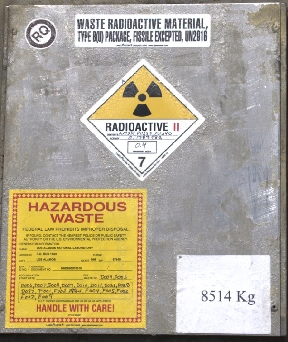
WATCHDOG GROUPS HEAD TO D.C.TO URGE CONGRESS TO CONFRONT “THE GROWING U.S. NUCLEAR THREAT”
Alliance for Nuclear Accountability
A national network of organizations working to address issues of nuclear weapons production and waste cleanup
Nuclear Watch New Mexico
May 14, 2015
WATCHDOG GROUPS HEAD TO D.C. TO URGE CONGRESS, OBAMA ADMIN.
TO CONFRONT “THE GROWING U.S. NUCLEAR THREAT;”
NEW REPORT SEEKS CUTS IN BOMB PLANTS, WARHEAD MODERNIZATION
DIVERTING SAVINGS TO CLEANUP AND WEAPONS DISMANTLEMENT
Dozens of community leaders from around the country will travel to Washington, DC next week to oppose U.S. Department of Energy (DOE) nuclear weapons projects, which they say will waste billions in taxpayer funds, damage the environment and undermine the nation’s non-proliferation goals. The group will meet with leading members of Congress, committee staffers, and top administration officials with responsibility for U. S. nuclear policies to press for new funding priorities.
Activists from nearly a dozen states are participating in the 27th annual Alliance for Nuclear Accountability (ANA) “DC Days.” They will deliver copies of ANA’s just-published report, The Growing U.S. Nuclear Threat ). The new 20-page analysis dissects the Obama Administration’s latest plans to spend hundreds of billions more on nuclear weapons programs without, the authors conclude, enhancing U.S. security.
Joining the Alliance will be four members of Nuclear Watch New Mexico: Dr. James Doyle, a nonproliferation expert fired by the Los Alamos Lab after writing a study arguing for nuclear weapons abolition; Chuck Montano, former LANL auditor and author of his just-released book Los Alamos: A Whistleblower’s Diary (http://losalamosdiary.com/index.html); Jay Coghlan, Executive Director; and Scott Kovac, Operations Director. “We will use this opportunity to represent New Mexicans who oppose the open checkbook policy for nuclear weapons by Congress to the National Labs,” Kovac stated.
Both Doyle and Coghlan have recently returned from the NonProliferation Treaty (NPT) Review Conference at the United Nations in New York City where they witnessed U.S. officials claiming that one trillion dollar plans for nuclear weapons modernization “contribute to and do not detract from progress on our NPT nuclear disarmament obligations.” But as Ralph Hutchison of the Oak Ridge Environmental Peace Alliance, the report’s editor, noted, “Massive spending on nuclear weapons ‘modernization’ increases the nuclear danger for the U.S. Lack of accountability at DOE wastes billions and puts the public at even greater risk. ANA members from across the country will urge policy-makers to cut programs that fund dangerous boondoggles. The money saved should be redirected to cleaning up the legacy of nuclear weapons research, testing and production.” Participants in DC Days include activists from groups that monitor such U.S. nuclear weapons facilities as Hanford, Lawrence Livermore, Rocky Flats, Los Alamos, Kansas City Plant, Pantex, Sandia, Oak Ridge, Savannah River and the Waste Isolation Pilot Plant.
The Alliance for Nuclear Accountability is a network of local, regional and national organizations representing the concerns of communities downwind and downstream from U.S. nuclear weapons production and radioactive waste disposal sites. As part of its DC Days, ANA will sponsor an Awards Reception honoring leaders of the movement for responsible nuclear policies on Monday evening, May 18. Honorees include U.S. Senator Harry Reid, U.S. Representative John Garamendi, Los Alamos whistleblower Dr. James Doyle, former FBI investigator of Rocky Flats Jon Lipsky, and nuclear campaigner Michael Keegan: The event will take place in Room B-340 of the Rayburn House Office Building from 5:30pm to 7:30pm.
After learning of his award, Dr. James Doyle replied, “It is an honor to be recognized by citizen organizations across the country who have been opposing nuclear weapons at the grassroots for decades. The Alliance for Nuclear Accountability is an important part of the fabric of our civil society and helps create an informed citizenry essential to our freedom and security. My case shows that even in America you must be careful when you question nuclear weapons. These groups have been trying to change that since before I knew what nuclear war would mean for humanity. I am proud to be working with them to eliminate nuclear weapons.”
– – 3 0 – –
Watchdog Groups Head to DC to Urge Congress and the Obama Administration to Confront “The Growing US Nuclear Threat”
New ANA report seeks cuts in bomb plants and warhead modernization; use savings for cleanup and weapons dismantlement
ACTION ALERTS
Nothing Found
It seems we can’t find what you’re looking for. Perhaps searching can help.
Nothing Found
It seems we can’t find what you’re looking for. Perhaps searching can help.
Interfaith Panel Discussion on Nuclear Disarmament - August 9
Nothing Found
It seems we can’t find what you’re looking for. Perhaps searching can help.
New Nuclear Media
Nothing Found
It seems we can’t find what you’re looking for. Perhaps searching can help.

